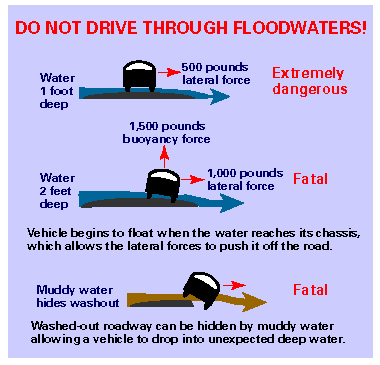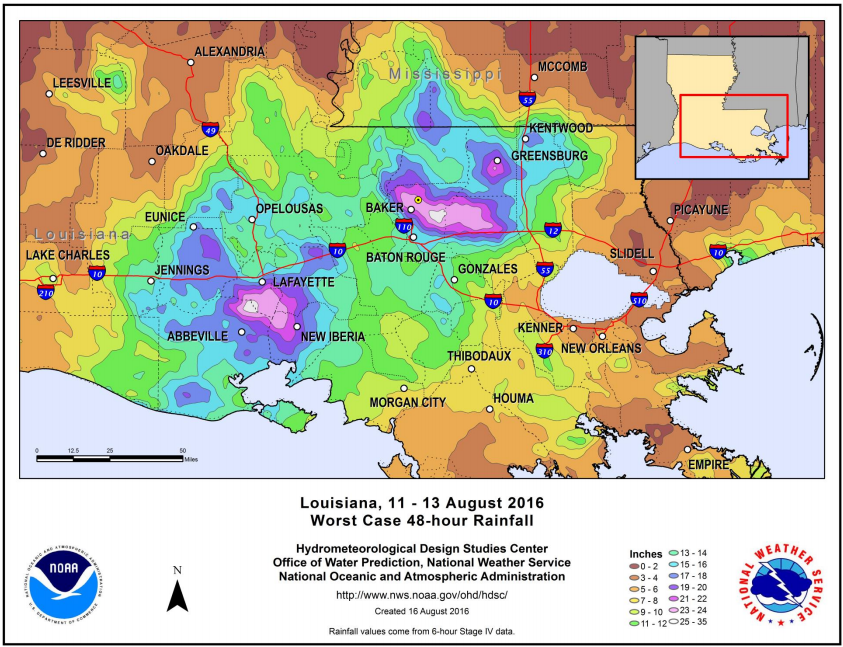I’m Not Noah, but let me give you a warning…
That’s how my Facebook post started recently. I had been looking at pictures of the flooding in Louisiana from August 10-13, 2016, and had lots of thoughts about the people in those areas. Scientists have classified this storm event’s recurrence interval as a 1,000-year storm in some places. Statistically this means that the event has a 0.1% chance of happening in any given year. In fact, this is Louisiana’s second such event THIS YEAR. And, there have been over eight flood events that are considered as 500-year (or 0.2% chance) storm events in the USA this year.
The death count is up to 12 as of now from the flooding. You should know that flooding is the second leading cause of weather fatalities, second only to heat, more than lightning, tornados and hurricanes. About 81 people a year on average die in a flood in the United States.
What is a 1-Percent Chance Storm Event?
We engineers classify rain events by their probability of happening again in a year. For example, a 1-percent chance storm event statistically has a 1-percent chance of occurring in ANY GIVEN YEAR. This 1-percent chance storm event also has inches of rain associated with it for specific areas. For New Orleans, the 1-percent chance storm is 14-inches in a 24 hour interval. This storm event was called in the past the 100-year storm event. This is actually known as the Average Recurrence Interval of 100-years. If you say 1 in 100, that is equivalent to 1-percent. It is statistically defined, and doesn’t mean that once you have a 100-year event you are good for your lifetime. It can happen in any year, or multiple times per year.
Go to 100-Year Flood – It’s All About Chance for more information on this.
For New Orleans, here are the Probabilities, Recurrence Intervals, and Expected Rainfall for those certain rain events:
And, in further looking at the recent Louisiana event, I found this analysis by the National Weather Service. It showed that there was 25-inches to 35-inches that fell in 48 hours, greatly exceeding the 100-year event, and classifying the storm at some locations as a 1,000-year storm, or a 0.1-percent chance storm. (See the featured image on this article.)
How Do I Tell if I’m in a Special Flood Hazard Area?
The Special Flood Hazard Area is the area shown on the flood map that is located lower than the Base Flood Elevation. This is the expected elevation of the 1-percent chance storm (100-year) water level. This area is determined by calculation of what level (elevation) that the creek will rise to during and just after the 1-percent chance rain event. Personally I would stay out of the 0.2-percent flood zone (500-year) as well. These flood zones are shown on FEMA’s Flood Insurance Rate Maps. and in my last article. The quickest way to find them is to go to the FEMA Map Service Center and enter your home address.
You will be presented with a portion of a map showing your location on it. At the top of the page you have 3 options to view the map. The “View Map” option is somewhat difficult to get used to zooming and moving around on, but if you’ll note what area of the flood map panel you’re in from the map on this page, it will be easier to find yourself. I prefer to “Save Map” which will save a TIFF image on your computer in a Zip formatted document. The “Interactive Map” is by far the easiest map to use to find your house. Browsing on this map is very similar to most online maps.
For more information, call a local land surveyor and ask for an Elevation Survey & Certificate to be completed.
I’m Not Shown in the Flood Zone, So I’m Clear, Right?
Most likely, but there are some special things you should consider. First is, are you in an area that has a creek that hasn’t been studied as yet? All creeks and ditches have a point that the water will rise to during and after a 1-percent chance rain event. You could have a dry ditch that runs by your house that only has water in it when it rains. This ditch could also overflow during a large rain event. This dry ditch will probably NEVER show up on a FEMA Flood Insurance Rate Map. Many small streams are the same way. You should have a surveyor or engineer who is familiar with assessing flood risk to look at your property and the contour maps in your area. If you have any doubt, obtain flood insurance. It will be the cheapest premium they have, but worth every penny if you ever have any flooding issues. You are likely NOT covered for flooding risk by your homeowner’s policy.
You should know that 30% of the flooding claims processed by FEMA are for areas outside of the 1-percent chance flood zone.
Last Warning – Flood Facts
- Most flood-related deaths are due to flash floods

- Fifty percent (50%) of all flash flood fatalities are vehicle related
- Ninety percent (90%) of those who die in hurricanes drown
- Most homeowner’s insurance policies do not cover floodwater damage
- Individuals and business owners can protect themselves from property losses by purchasing flood insurance through FEMA’s National Flood Insurance Program.
J. Keith Maxwell is a Professional Engineer and Land Surveyor in Alabama. He knows a thing or two about flooding and wishes he could show everyone looking for a house where not to buy…in OR NEAR a flood zone.


